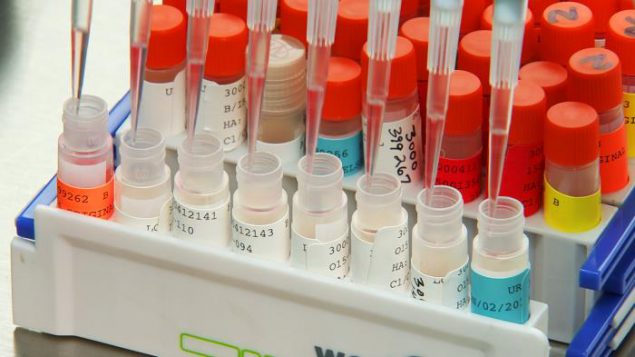Cell-Based Flu Vaccines
Brand name: Flucelvax Quadrivalent
exclamation square light iconGetting a flu vaccine is more important than ever during 2020-2021 to protect yourself and the people around you from flu, and to help reduce the strain on healthcare systems responding to the COVID-19 pandemic.
- What are cell-based flu vaccines?
- Who can get Flucelvax Quadrivalent?
- Why has a cell-based flu vaccine been developed?
- How is the cell-based vaccine manufacturing process different than the traditional egg-based manufacturing process?
- What is the significance of FDA approving cell-based candidate vaccine viruses for use in the Flucelvax Quadrivalent cell-based flu vaccines?
- What are the possible benefits of using cell-based influenza vaccines?
- What were the results of the clinical trials using cell-based technology?
- Has cell-based technology been used before?

Cell-based flu vaccine production does not require chicken eggs because the vaccine viruses used to make vaccine are grown in animal cells.
What are cell-based flu vaccines?
‘Cell-based’ refers to how the influenza (flu) vaccine is made. Most inactivated flu vaccines are produced by growing flu viruses in eggs. The flu viruses used in the cell-based vaccines are grown in cultured cells of mammalian origin instead of in hens’ eggs.
Flucelvax Quadrivalent is the only cell-based inactivated flu vaccine that has been licensed by the FDA for use in the United States.
Who can get Flucelvax Quadrivalent?
Flucelvax Quadrivalent is licensed for use in people 4 years and older.
Why has a cell-based flu vaccine been developed?
Cell-based flu vaccine production does not use flu viruses grown in eggs and, therefore, is not dependent on the supply of eggs. In addition, cell-based flu vaccines that use cell-based candidate vaccine viruses (CVVs) have the potential to offer better protection than traditional, egg-based flu vaccines. The viruses used to make cell-based vaccines may be more similar to circulating “wild” flu viruses than the viruses used to make egg-based vaccines. In one study published in the Journal of Infectious Diseasesexternal icon among Medicare beneficiaries 65 years and older, cell-based vaccine provided greater protection against flu-related hospitalizations than standard-dose, egg based vaccine.
For the 2020-2021 flu season, all four flu viruses used in the Flucelvax Quadrivalent are cell-derived, making the vaccine egg-free.
How is the cell-based vaccine manufacturing process different than the traditional egg-based manufacturing process?
The cell-based vaccine manufacturing process uses animal cells (Madin-Darby Canine Kidney, or MDCK cells) as a host for the growing flu viruses instead of fertilized chicken eggs. For the 2020-2021 season, the viruses provided to the manufacturer to be grown in cell culture are cell-derived rather than egg-derived. Learn more about the cell-based flu vaccine manufacturing process on CDC’s How Flu Vaccines are Made web page.
What is the significance of FDA approving cell-based candidate vaccine viruses for use in the Flucelvax Quadrivalent cell-based flu vaccines?
Growing flu viruses in eggs can introduce changes (called egg-adapted changes) that can cause differences between the viruses in the vaccine and the ones that are circulating. These changes may have important implications for the body’s immune response to vaccination. For example, egg-adapted changes could cause the body’s immune system to produce antibodies that are less effective at preventing disease caused by the specific flu viruses in circulation. FDA’s approval of cell-based CVVs for use in cell-based flu vaccines could possibly improve the effectiveness of cell-based flu vaccines.
What are the possible benefits of using cell-based flu vaccines?
Observational studies have shown greater protection against flu or flu-like illness among people who received Flucelvax compared to those who received standard-dose egg-based vaccines.
A potential advantage of cell culture technology is that it might permit faster start-up of the vaccine manufacturing process in the event of a pandemic. The cells used to manufacture Flucelvax Quadrivalent are kept frozen and “banked.” Cell banking ensures an adequate supply of cells is readily available for vaccine production. Growing the flu viruses in cell culture for the manufacture of Flucelvax Quadrivalent is not dependent on an egg supply. Cell-based flu vaccines that are produced using CVVs have the potential to be more effective than traditional egg-based flu vaccines.
What were the results of the clinical trials using cell-based technology?
A clinical trial of the previous trivalent formulation of Flucelvax demonstrated effectiveness and safety among persons 18 through 49 years old. In immunogenicity studies among people 18 years and older and 4 through 17 years old, Flucelvax Quadrivalent was found to produce a similar immune response to the trivalent formulation. Post-vaccination symptoms were typical of those seen with other injectable flu vaccines.
Has cell-based technology been used before?
Cell culture technology has been used to produce other U.S.-licensed vaccines, including vaccines for rotavirus, polio, smallpox, hepatitis, rubella and chickenpox.
Cell-based flu vaccines have been approved for use in many European countries.
